As cities worldwide continue to expand, the challenges of urbanization become increasingly evident—one of the most pressing issues is the “urban heat island” effect. This phenomenon occurs when cities experience higher temperatures than surrounding rural areas due to the concentration of buildings, roads, and human activities. These surfaces absorb and re-radiate heat, causing a significant temperature rise, especially during summer.
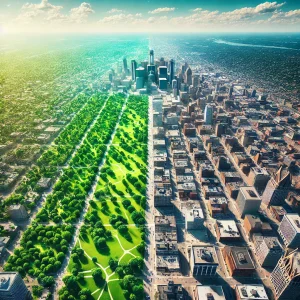
Urban Heat Islands and Environmental Impact
Urban heat islands (UHIs) exacerbate climate change’s effects on cities, resulting in hotter days, warmer nights, and less temperature variability. This heat intensification contributes to higher energy consumption, worsened air quality, and increased greenhouse gas emissions. The environmental impacts are particularly noticeable in cities like Detroit, where industrial and urban activities converge, creating an even more challenging climate environment.
While the situation may seem daunting, cities increasingly turn to nature for solutions. By integrating green spaces into urban landscapes, municipalities are discovering practical ways to mitigate rising temperatures, benefiting the environment and residents.
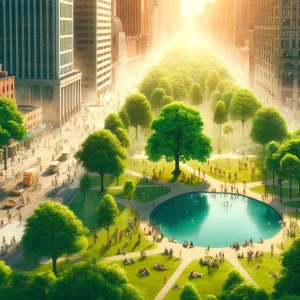
How Green Spaces Combat Urban Heat
One of the most promising strategies for addressing urban heat islands is the development of green spaces. These areas, including parks, tree-lined streets, and urban gardens, provide a cooling effect by absorbing less heat than concrete or asphalt. Trees, in particular, offer the dual benefit of shading streets and buildings while releasing moisture into the air through transpiration, further cooling the surrounding areas.
In cities like Detroit, introducing more green spaces has become a focal point in fighting urban heat. Community projects that plant trees create parks and “green” streets not only cool the environment but also promote sustainability by improving air quality and reducing the carbon footprint. Greening vacant lots or turning old industrial spaces into parks can significantly lower neighbourhood temperature, making cities more livable.
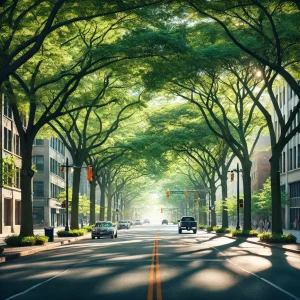
Public Health Benefits
Beyond their environmental impact, green spaces also offer critical public health benefits. High temperatures in cities can lead to heat-related illnesses, particularly in vulnerable populations like the elderly and those with pre-existing health conditions. By creating cooler, shaded environments, cities can reduce the risk of heatstroke and other heat-related health emergencies.
For instance, in Detroit, which has historically faced economic and environmental challenges, green initiatives are helping to improve residents’ well-being. Tree-lined streets and public parks provide a more relaxed atmosphere and places for physical activity, relaxation, and social interaction. Studies have shown that increased access to green spaces can reduce stress, improve mental health, and lower the risk of cardiovascular disease—important factors in creating healthier communities.
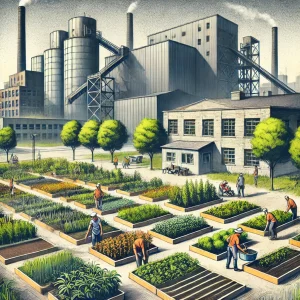
Economic Benefits of Greening Cities
Urban greening also presents significant economic advantages. In cities that embrace green infrastructure, such as Detroit, property values often rise in areas near parks and tree-filled streets. Green spaces make neighbourhoods more attractive to residents and investors alike. Trees and other greenery also help reduce energy costs by cooling buildings and lessening the demand for air conditioning during hot summer months. This translates into tangible financial savings for both homeowners and city governments.
In Detroit, urban greening projects are often linked to revitalization efforts, where the transformation of once-neglected areas into vibrant, green spaces has contributed to economic recovery. For example, neighborhoods once dominated by abandoned buildings and vacant lots are being converted into parks and community gardens, attracting new businesses and residents.
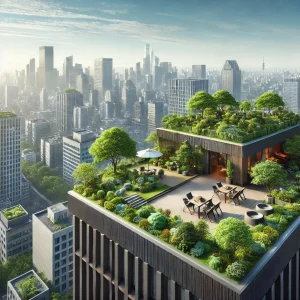
Community Projects in Detroit and Beyond
While Detroit’s green space initiatives are still expanding, several projects have made a notable impact. Community groups and city planners have begun efforts to plant trees and establish urban gardens throughout the city, transforming once-derelict spaces into thriving green environments. These initiatives are improving the urban landscape and involving residents in creating a greener, cooler future for their city.
Across the U.S., similar projects are gaining momentum. In cities like New York and Los Angeles, “green roofs” and vertical gardens are being integrated into new building designs, providing aesthetic appeal and functional benefits in the fight against urban heat. These examples demonstrate the growing recognition that green spaces are vital in creating more resilient urban environments.

As cities like Detroit continue to confront the growing challenges of climate change, urban heat islands will remain a significant concern. However, the solution lies in part in reconnecting cities with nature. Urban areas can combat rising temperatures while improving public health and boosting local economies by expanding green spaces, planting more trees, and greening city streets. Detroit’s efforts to integrate green spaces into its landscape provide a promising model for other cities looking to combat urban heat and create more sustainable, livable communities.
As we move forward, the lessons learned from Detroit’s greening initiatives will undoubtedly shape the future of urban planning, making cities cooler, healthier, and more resilient to a changing climate.